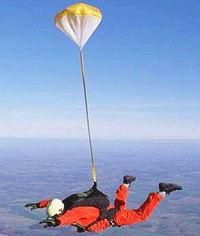
The more you learn about your equipment, the safer you will be. Read your user manual thoroughly because every rig is different. During a none jumping day take time out to do a regular inspection of your main parachute and your container. Inspect every visible component part. Ask your reserve packer or rigger to teach you what to look for.

Home - Assembly - Safety System - Maintenance
Main Packing - Reserve Packing - Rigging - Training - Tandem
Some manufacturers are offering retrofit systems to convert from soft housings to hard housings on the cutaway system. If you have soft housings that are suspect or you would just like some reassurance then try this test on your system: fit the rig for normal use and set up the risers to suspend you in a training harness, practice a normal cutaway and reserve pull as you would expect to do it in a live emergency. You may want to repeat this test for smaller zero porosity canopies and have some one assist you by pulling down on the harness to increase the tension, as a radical malfunction will greatly increase the tension.
This report was written by Allan Hewitt
An experienced jumper 2000+ jumps was doing a sit flying jump using a baggy nylon tracksuit. During the skydive, the jacket inflated over the rig. On deployment the jumper had hold of the BOC toggle and part of the jacket. When he attempted to deploy the pilot chute it tangled with the jacket, the jumper managed to clear the pilot chute but opened very slow.
We must assume that every thing we wear is classed as parachute equipment during all parachute descent, and looking closely at clothing is just as important as any other piece of skydiving equipment.
When using baggy tracksuits the type of material should be taken into consideration and how the top is secured. Check before emplaning to make sure nothing can affect the deployment sequence.
This report was written by Allan Hewitt
I've had two reports that seem very similar, in both cases the jumpers reported having a bag lock malfunction and cutaway to deploy their reserve parachute.
Conclusions
In both cases the jumpers reported that the lines entangled on the deployment bag around tube stoes that seem to be installed too close to each other. One jumper had his rigger install a new method for attaching the tube stoes so the lines can't entangle with each other. The other jumper said it's made him more careful with his packing and now he makes sure that his lines have short loops through the tube stoes.
Recommendations
Bag locks have been around for a long time, before tube stoes came onto the market. The problem is still the same now as it was before tube stoes, however, the strength of the tube stoes increase the chances of a bag lock, remaining locked, but an elastic band might have given way and released the lock. The solution is down to how you pack your lines. If you're not sure how to pack to prevent bag locks get some packing training because they are easy to avoid.
This report was written by Allan Hewitt
We've had a report of a sit flyer who had a premature deployment on his main parachute. His deployment method was a BOC but the conversion from leg strap meant that the bridle line was not secure.
Conclusions
It's believed that the bridle line was flapping during freefall which was exaggerated by the jumpers body position of sit flying. The flapping bridle line caused the main pin to be pulled free and the deployment bag fell out. Fortunately, the BOC pilotchute was also pulled free by the deploying canopy. Normally this could have resulted in a horse shoe malfunction.
Recommendations
In this case it was the equipment that was at fault which was caused by a conversation that was not done properly. However,when the rig was used in formation skydiving this problem was not apparent. Sit flying, however, requires more thought to equipment and it's design. If you're intending to do freefly jumps make sure your equipment is suitable for this discipline. Riggers must ensure that the bridle line can't prematurely load the main pin with any force that could make it release before the pilot chute has been deployed.
This report was written by Allan Hewitt
Two helmets made their way to earth leaving the owners without head protection, both landed without causing injury to others.
Conclusions
One came off after opening when the jumper was reaching up to clear twists and one left the aircraft by itself when the jumpmaster opened the door of the aircraft.
Recommendations
Lose items can cause severe damage, both in the aircraft and when landing, make sure that your equipment is secure at all times.
This report was written by Allan Hewitt
I have received three injury reports caused by bad landings on reserve parachutes. One jumper went from his 170 sq ft main to his 135 sq ft reserve and misjudged his flare and landed badly. Another jumper went from his 220 sq ft main to a 24 ft round reserve and landed hard. Another jumper went from his135 sq ft main parachute to his 120 sq ft reserve and landed badly.
Conclusions
The first jumper stated that he was surprised at the speed he came into land and when he flared, nothing seemed to happen. This is typical of a skydiver who downgrades to a smaller canopy too soon. The reality is that he went from a 170 to a 135 without any training or experience on smaller canopies. He should not have been jumping such a small reserve with his experience level.
The second jumper had never jumped a round parachute before and was surprised when he ended up on one. He knew his reserve was a round but had never thought about having to use it or land it. He bought it second hand and was happy to have his own system and no one had ever asked him if he knew how to land one. The third jumper was witnessed doing a very late rapid flare which usually works ok on his ZP main parachute but it had no effect on his reserve parachute.
Recommendations
Always assume that you will need your reserve one day and think about it's flying and landing characteristics so you can learn the best way to fly and land it safely. Your reserve should be a size that you know you can land safely and after deployment you need to go back to being a student and practice your flare while at a safe altitude. Ask your instructor for advice,especially if the main and reserve parachutes are not a good match.
This report was written by Allan Hewitt
During a routine skydive a jumper exited the aircraft and almost immediately his visor completely misted up and all of his vision had gone. He was supposed to dock on an eight man formation but lost sight of all the other skydivers. He tried to reach inside of his helmet and clean his visor but failed to make a difference. He wasn't sure what altitude he was at so estimated his pull height and deployed when he thought he was low enough.
Conclusions
The jumper said that his helmet had misted up in the aircraft but he had wiped it clear before exit. He had about two hundred jumps and it had never happened previously. After a little bit of investigating it turns out that he had, over many occasions, wiped away the protective coating that prevented his visor from misting. He was not aware that his helmet visor had a protective coating or how to maintain it. The rapid temperature change from a warm cosy aircraft into a freezing 120 mph slip stream was the perfect components that helped to make this happen. The jumper took his hemet off under canopy to find himself at five thousand feet and he landed without his helmet on because he couldn't clear it and keep it clear.
Recommendations
Different helmet manufacturers have different types of visors manufactured from various types of materials. Some visors are manufactured with a protective film while others need a special cleaning and protective seal to be administered on a regular basis. Make sure you are aware how to maintain your visor and learn how to recognise when a problem could occur. This jumper was lucky to have avoided a mid air collision from those exiting after him. Be careful when using an anti fog spray, some of them can react with the visors own protective covering and make the situation worse. Clean protected visors under luke warm water and be very gentle when wiping it while wet and us a hairdryer, as long as it's not too hot, instead of a cloth to dry it. Get to know what's best for your helmet visor.
This report was written by Allan Hewitt
An experienced jumper took part in a large formation skydive in cold weather. This was the first time he had worn his rather large gloves with thick padding to prevent cold fingers. On deployment he dropped his pull out pad and could not relocate it. He pulled his cutaway handle and his reserve handle, then landed safely under his reserve.
Conclusions
Wearing gloves in very cold weather is important but having gloves that you can feel through and confidently carry out all your drills is even more important. Everyone has a favorite kind of glove but when faced with very cold weather it's easy to be tempted to go for thicker gloves. Silk liners may seem ridiculously flimsy but because of the layer effect they are surprisingly effective and do not increase the thickness. This incident also revived a long age old debate about whether he needed to cutaway first.
Recommendations
Stay away from thick padded gloves, if it's a very cold winter day and your normal gloves are not good enough use a pair of silk liners inside your normal gloves or stay on the ground. The jumper in this report didn't want to jump because of his gloves but because of peer pressure and the big formation skydive he gave in to temptation.
This report was written by Allan Hewitt
At the time of writing there were a few incidents being investigated with reference to soft housings on cutaway systems. Many skydivers have reporting hard pulls with the cutaway handle during emergency procedures, and there are some reports of one riser failing to separate causing main and reserve entanglements.
This potential problem has been reported on rigs that do not have a dedicated channel for the cutaway cable. For example some rigs with soft housings have a system where the cutaway cable is routed through a channel, which makes sure the cutaway is the same as with a hard housing. The rigs which are presenting some concern are those with soft housings which do not imitate the mechanics of a hard housing system.